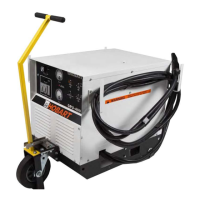(4) Always check circuit fuses, circuit breakers and the position of switches first in troubleshooting.
The incorrect positioning of a switch may cause a condition which could be misinterpreted as a fault.
(5) Electrical component symbols, which are used on schematic diagrams, and their legends to iden-
tify components, may be used in the troubleshooting chart
(in parentheses after the item name)
to
help maintenance personnel identify parts on the schematic diagrams.
3. Equipment for Troubleshooting
A good quality multi-scale voltohmmeter is the only instrument required for troubleshooting. However, for
checking certain erratic, intermittent, or phase relationship problems, a good oscilloscope is strongly rec-
ommended.
4. Safety
WARNING: HIGH VOLTAGE - ELECTRIC SHOCK AND FIRE CAN KILL! EXER-
CISE EXTREME CARE TO AVOID CONTACT WITH HIGH VOLTAGE LEADS
AND COMPONENTS WHICH COULD CAUSE SERIOUS SHOCK AND INJURY
IF TOUCHED WHEN TROUBLESHOOTING OR OPERATING THE EQUIPMENT.
STAY CLEAR OF MOVING PARTS. LOCATE EQUIPMENT IN A SAFE ENVI-
RONMENT. HAVE PROPER SAFETY EQUIPMENT AVAILABLE. DO NOT AT-
TEMPT OPERATION OR REPAIR WITHOUT ADEQUATE TRAINING.
5. Voltages of Interest
A. Across the secondary on all 3 phases - 66 VAC + 10% *
B. To secondary coil center tap on all phases - 33 VAC
+ 10% *
* The
+ 10% refers to the possibility of input voltage being out of balance or not at the nominal
value.
C. Across the 115 VAC receptacle - 115 VAC
+ 10% *
D. Between X1 and X3 on Fuse Block - 37 VAC
+ 10% *
E. Test Point Values for PC board
A control board malfunction will probably result in
(a)
a loss of output voltage,
(b)
inability to produce
full load current, or
(c)
output voltage too high or too low. See Section 3-3, Figure 2 for nominal test
values between a few selected test points shown in Section 3-3, Figure 1.
NOTE: All potentiometer operating values are preset at the factory, and normally should not have to be
reset in the field. If a need arises that would indicate the need for field adjustments, please contact the
factory at Troy, Ohio. Typically, R109, (28 V output) is the only factory set value which the customer’s
use might dictate a minor change in setting. For example, long cables might need a few tenths of a volt
higher set values to compensate for the cable drop.
OM-2010
3-4 April 10/89 Revised
Page 2

